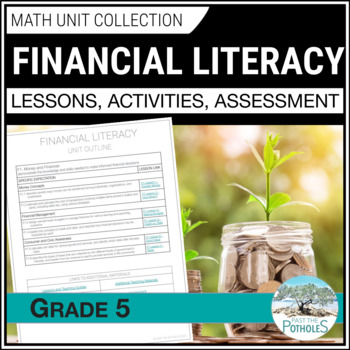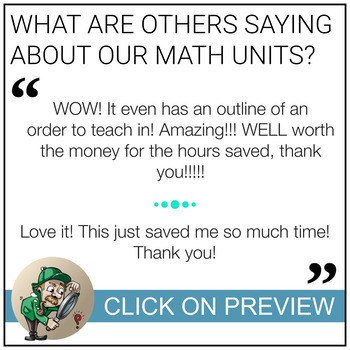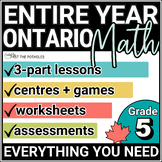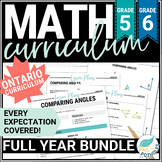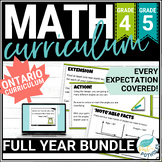Financial Literacy Ontario Unit - Sales Tax Budgeting Credit Debt Grade 5 Math
- PDF
- Google Apps™

What educators are saying
Also included in
- Ontario Grade 5 math teachers! Your entire year of Ontario math can be planned and ready for you to teach! Begin the year with the First 20 Days of Math unit and follow our Course of Study for the entire school year. This comprehensive, EDITABLE math program covers ALL UNITS of the grade 5 Ontario mPrice $115.00Original Price $181.00Save $66.00
- How would it feel to have ALL your math planned for the year? Get comprehensive, EDITABLE math units that cover ALL EXPECTATIONS of grade 5 AND grade 6 Ontario Math Curriculum - engaging lessons, hands-on activities, worksheets, math centre task cards, games, assessments.Students will learn to use aPrice $175.00Original Price $350.00Save $175.00
- Ontario teachers love these COMPLETE and UPDATED math units. You'll have access to our best resources for SEL First 20 Days, Numbers, Operations, Patterning, Algebra, Coding, Geometric Reasoning, Location & Movement, Measurement, and Financial Literacy. These user-friendly, comprehensive, and EDPrice $175.00Original Price $360.00Save $185.00
Description
This editable, engaging Grade 5 Ontario Personal Financial Literacy Unit covers budgeting Canadian money, taxes, credit vs. debt, calculating value, etc. This low-prep unit includes 3- part Google Slides lessons, practice worksheets, review activities, games, centres, assessments, and Ontario math report card comments!
ABOUT THIS GRADE 5 FINANCIAL LITERACY UNIT
✔ Everything is fully editable (just make a copy)
✔ Lessons and activities use research-based best practices (this is NOT just a collection of print-and-go worksheets)
✔ In-person and digital options for face-to-face and distance learning
✔ Text isn't locked to allow text-to-speech software for student accommodations
✔ Pages are set to 8.5x11 for easy printing
✔ Almost all files are Google Slides files with PDF versions
✔ Aligned to Ontario Curriculum standards but very easily adapted for other grades and curriculums.
LOCK IN THIS INTRODUCTORY PRICE! **You will have FREE LIFETIME UPDATES for any future updates and additions.**
WHAT’S INCLUDED?
⇧ Please read the detailed PREVIEW to get a clear idea of what to expect with your purchase ⇧
Included in this unit:
→ 9-page teacher guide for teaching the unit including suggestions to incorporate the included materials and how to effectively teach 3-part math lessons (provided in PDF).
→ 6 three-part math lessons in Google Slides (will download to PPT or Keynote automatically) ready to project. Text boxes added for virtual teaching.
→ PDF teaching guide for each lesson with slides, teaching notes, answers and links
→ Unit Outline to provide an overview of expectations covered and quick links to access the lesson you need
→ Expectations chart in easy-to-understand language for student accountability and parent communication
→ Assessment guide and success criteria, rubric, for student notebooks
→ 3 Concept pages for student notebooks - great for notes and open-ended assessment.
→ Any blackline masters needed
→ 2 Worksheets for extra practice with answer key (provided in PDF for easy printing, Google Slides for editing, and a student Google Slides for online teaching).
→ Vocabulary - with and without definitions, with space for translation for ELL students and as Word Wall cards.
→ Interactive Notebook template and instructions to complete
→ Balanced Math Centres / Stations / Rotations to complement the unit
→ Review class game
→ Links to websites that can provide additional practice
→ Final unit test (provided in PDF for easy printing, Google Slides for editing and Google Forms for remote learning).
→ Answer key for unit test
Specific topics covered in lessons:
✷ Transferring money
✷ Understanding tax
✷ Calculating totals (dollars and cents) including sales tax
✷ Creating simple budgets
✷ Understanding credit and debt
✷ Calculating value with unit rates
Each lesson includes:
✎ Minds On - brief activity to engage the class
✎ Action - usually problem-based work for partners or small groups to collaborate and solve
✎ Consolidation - whole class discussion and consolidation of learning
✎ Formative Assessment - quick question to check student understanding
✎ Journal - improve student communication skills and get to know their mathematical thinking better
- Lessons often contain open ended questions or parallel tasks to allow students of different levels to achieve success.
- The focus is on higher level thinking skills and process, not simply memorizing facts and algorithms.
❉ This is a Google Drive product. The downloaded file will give you a unit cover page, a 13-page teacher notes package and a link to access all files through Google Drive. Google Drive accounts are free and easy to create with just an email address. However, if you don't use Google Drive, the Slides files will download and convert to PowerPoint.
♻ We strive to be environmentally conscious by creating digital products. Please don't print more than is necessary!
RELATED PRODUCTS
Take at look at other related math products:
Problem Solving with Fractions - Muffin Mania - FREEBIE!
Reasoning and Proving - Math Process - Student Activity
Math About Me - review, assessment, reflection
Math Scavenger Hunt - junior grades
Financial Literacy Review Game - Tug 'o War with Distance Learning option
If you want more math support, take a look at this:
Entire Year of Math - complete grade 5 math program!!
Complete set of math report card comments? We have that!
Math Report Card Comments - Grade 5
▼▼▼▼▼▼▼▼▼▼▼▼▼▼▼▼▼▼▼▼▼▼▼▼▼▼▼▼▼▼▼▼▼▼▼▼▼▼▼▼▼▼▼▼▼▼▼▼▼▼▼▼▼▼▼▼▼▼▼▼▼▼▼▼▼▼▼▼▼▼▼▼▼▼▼▼▼▼▼▼
If you like this product don’t forget to leave positive FEEDBACK. Not only does it help others find it, but you also EARN CREDITS towards future purchases!
_______________________________________________________________________________________
Join our MAILING LIST for product notifications, freebies and updates straight into your mailbox!!
TERMS OF USE - © Past The Potholes Ltd.
This item is a paid digital download from my TpT store: www.teacherspayteachers.com/Store/Past-The-Potholes
It is for personal use in one classroom only. Copies are only allowed for your own classroom use.
This item is bound by copyright laws. Redistributing, editing, selling, or posting this item (or any part thereof) on the internet are all strictly prohibited without first gaining permission from the author. Violations are subject to the penalties of the Digital Millennium Copyright Act.

